

Meg Whitman: Unlocking IT with Big Data. How does your company stack up to the industry in software quality and testing?
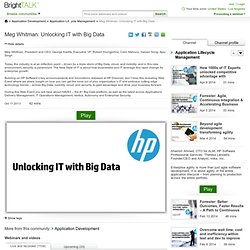
For instance, did you know that, despite the rapid rise in mobile testing (from 31% in 2012 to 55% in 2013), close to half of respondents this year report that they still lack mobile testing experts? Mark your calendar for a dynamic discussion with CapGemini and HP where we’ll share results from the World Quality Report. This report is the industry’s most comprehensive annual research study focused on insights about the latest trends and best practices in application quality assurance, testing methodologies, tools, and QA processes. Making data analytics work: Three key challenges. By now, most companies recognize that they have opportunities to use data and analytics to raise productivity, improve decision making, and gain competitive advantage.
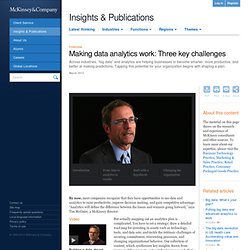
“Analytics will define the difference between the losers and winners going forward,” says Tim McGuire, a McKinsey director. Video Building a data-driven organization Matt Ariker, COO, McKinsey Consumer Marketing Analytics Center Play video But actually mapping out an analytics plan is complicated. Transforming data Matthias Roggendorf, McKinsey senior expert “Big data: What’s your plan?” Above, in the first of three videos, Tim McGuire sets out the triple challenge that companies face: deciding which data to use (and where outside your organization to look), handling analytics (and securing the right capabilities to do so), and using the insights you’ve gained to transform your operations. Making Advanced Analytics Work for You. Artwork: Tamar Cohen, The Big Quick, 2010, silk screen collage on vintage book pages, 40" x 50" Big data and analytics have rocketed to the top of the corporate agenda.
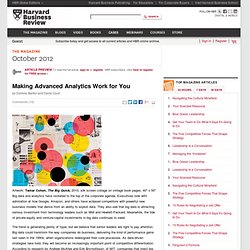
Executives look with admiration at how Google, Amazon, and others have eclipsed competitors with powerful new business models that derive from an ability to exploit data. They also see that big data is attracting serious investment from technology leaders such as IBM and Hewlett-Packard. Meanwhile, the tide of private-equity and venture-capital investments in big data continues to swell. The trend is generating plenty of hype, but we believe that senior leaders are right to pay attention.
Even so, our experience reveals that most companies are unsure how to proceed. Many CEOs, too, recall their experiences with customer relationship management in the mid-1990s, when new CRM software products often prompted great enthusiasm. Given this history, we empathize with executives who are cautious about big data. 1. Predictive Cyber Security: Big Data Analytics. Join this webinar and learn why consistency is the hallmark of an effective, agile organisation.

With thousands of moving parts, ensuring that every user, every system is being managed consistently is critical. This webinar will show you how a best practice IT systems management software effectively defines, manages, applies and enforces IT policies across groups of machines. A state-of-the art Policy Management system streamlines the process of creating, setting and remotely applying IT policies to groups of systems across a distributed organisation. Administrators need to be able to view all policies from a single dashboard, customise them and assign them based on organisation, group, machine type, platform or any dynamic view of machines to ensure all systems are in compliance.
By automating management by policies and enforcement, administrators can then take immediate action to remediate any system that is not in compliance. State Street's Chief Scientist on How to Tame Big Data Using Semantics. Semantic databases are the next frontier in managing big data, says State Street's David Saul.
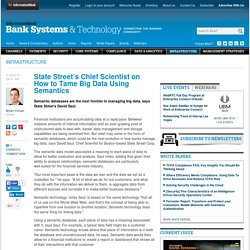
Financial institutions are accumulating data at a rapid pace. Between massive amounts of internal information and an ever-growing pool of unstructured data to deal with, banks' data management and storage capabilities are being stretched thin. But relief may come in the form of semantic databases, which could be the next evolution in how banks manage big data, says David Saul, Chief Scientist for Boston-based State Street Corp. The semantic data model associates a meaning to each piece of data to allow for better evaluation and analysis, Saul notes, adding that given their ability to analyze relationships, semantic databases are particularly well-suited for the financial services industry.
"Our most important asset is the data we own and the data we act as a custodian for," he says. Interview with David Saul of State Street Corp on semantic technology www.revelytix.com. SearchCIO TechTarget recently published a two part conversation with David Saul, Chief Scientist at State Street Corp.
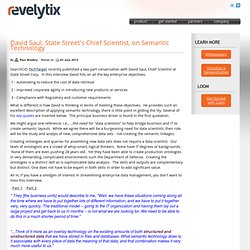
In this interview David hits on all the key enterprise objectives: 1 - Automating to reduce the cost of data retrieval 2 - Improved corporate agility in introducing new products or services 3 - Compliance with Regulatory and customer requirements What is different is how David is thinking in terms of meeting these objectives. We might argue one reference, i.e., ...the need for "data scientists" to help bridge business and IT to create semantic layouts. Creating ontologies and queries for assembing new data sets does not require a data scientist. All in, if you have a smidgen of interest in streamlining enterprise data management, you don't want to miss this interview.
Part 1 Part 2 "...Think of it more as an overlay technology on the existing amounts of both structured and unstructured data that we have stored in files and databases.